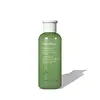What's inside
What's inside
 Key Ingredients
Key Ingredients

 Benefits
Benefits

 Concerns
Concerns

 Ingredients Side-by-side
Ingredients Side-by-side

Water
Skin ConditioningPropanediol
SolventButylene Glycol
HumectantHydrogenated Polyisobutene
EmollientCeramide AP
Skin Conditioning1,2-Hexanediol
Skin ConditioningBetaine
HumectantBehenyl Alcohol
EmollientAmmonium Acryloyldimethyltaurate/Vp Copolymer
Glyceryl Caprylate
EmollientParfum
MaskingTromethamine
BufferingCarbomer
Emulsion StabilisingAcrylates/C10-30 Alkyl Acrylate Crosspolymer
Emulsion StabilisingEthylhexylglycerin
Skin ConditioningDisodium EDTA
Camellia Sinensis Leaf Extract
AntimicrobialLinalool
PerfumingLimonene
PerfumingButylphenyl Methylpropional
PerfumingCitronellol
PerfumingHexyl Cinnamal
PerfumingWater, Propanediol, Butylene Glycol, Hydrogenated Polyisobutene, Ceramide AP, 1,2-Hexanediol, Betaine, Behenyl Alcohol, Ammonium Acryloyldimethyltaurate/Vp Copolymer, Glyceryl Caprylate, Parfum, Tromethamine, Carbomer, Acrylates/C10-30 Alkyl Acrylate Crosspolymer, Ethylhexylglycerin, Disodium EDTA, Camellia Sinensis Leaf Extract, Linalool, Limonene, Butylphenyl Methylpropional, Citronellol, Hexyl Cinnamal
Water
Skin ConditioningPropanediol
SolventDipropylene Glycol
HumectantGlycerin
HumectantGlycereth-26
Humectant1,2-Hexanediol
Skin ConditioningC12-14 Alketh-12
EmulsifyingMethyl Gluceth-20
HumectantDiphenyl Dimethicone
EmollientTriethylhexanoin
MaskingButylene Glycol
HumectantLimonene
PerfumingPolyquaternium-51
Skin ConditioningGlyceryl Caprylate
EmollientEthylhexylglycerin
Skin ConditioningPolyglyceryl-10 Oleate
Skin ConditioningHydrogenated Lecithin
EmulsifyingAcrylates/C10-30 Alkyl Acrylate Crosspolymer
Emulsion StabilisingSodium Phytate
Arginine
MaskingSodium Hyaluronate
HumectantCitric Acid
BufferingLavandula Angustifolia Oil
MaskingLinalool
PerfumingVaccinium Angustifolium Fruit Extract
Skin ProtectingCitrus Aurantium Dulcis Peel Oil
MaskingPanthenol
Skin ConditioningAllantoin
Skin ConditioningCaprylic/Capric Triglyceride
MaskingMaltodextrin
AbsorbentSaccharide Hydrolysate
HumectantPentylene Glycol
Skin ConditioningTocopherol
AntioxidantEuterpe Oleracea Fruit Extract
Rubus Idaeus Leaf Extract
Skin ConditioningWater, Propanediol, Dipropylene Glycol, Glycerin, Glycereth-26, 1,2-Hexanediol, C12-14 Alketh-12, Methyl Gluceth-20, Diphenyl Dimethicone, Triethylhexanoin, Butylene Glycol, Limonene, Polyquaternium-51, Glyceryl Caprylate, Ethylhexylglycerin, Polyglyceryl-10 Oleate, Hydrogenated Lecithin, Acrylates/C10-30 Alkyl Acrylate Crosspolymer, Sodium Phytate, Arginine, Sodium Hyaluronate, Citric Acid, Lavandula Angustifolia Oil, Linalool, Vaccinium Angustifolium Fruit Extract, Citrus Aurantium Dulcis Peel Oil, Panthenol, Allantoin, Caprylic/Capric Triglyceride, Maltodextrin, Saccharide Hydrolysate, Pentylene Glycol, Tocopherol, Euterpe Oleracea Fruit Extract, Rubus Idaeus Leaf Extract
Ingredients Explained
These ingredients are found in both products.
Ingredients higher up in an ingredient list are typically present in a larger amount.
1,2-Hexanediol is a synthetic liquid and another multi-functional powerhouse.
It is a:
- Humectant, drawing moisture into the skin
- Emollient, helping to soften skin
- Solvent, dispersing and stabilizing formulas
- Preservative booster, enhancing the antimicrobial activity of other preservatives
Acrylates/C10-30 Alkyl Acrylate Crosspolymer is a synthetic polymer. It is used to thicken and improve the texture of products. Due to its properties, it can prevent water and oil ingredients from separating.
Butylene Glycol (or BG) is used within cosmetic products for a few different reasons:
Overall, Butylene Glycol is a safe and well-rounded ingredient that works well with other ingredients.
Though this ingredient works well with most skin types, some people with sensitive skin may experience a reaction such as allergic rashes, closed comedones, or itchiness.
Learn more about Butylene GlycolEthylhexylglycerin (we can't pronounce this either) is commonly used as a preservative and skin softener. It is derived from glyceryl.
You might see Ethylhexylglycerin often paired with other preservatives such as phenoxyethanol. Ethylhexylglycerin has been found to increase the effectiveness of these other preservatives.
Glyceryl Caprylate comes from glycerin and caprylic acid, a fatty acid from coconut. It has emollient and emulsifier properties.
As an emollient, it helps hydrate your skin. Emollients work by creating a barrier on your skin to trap moisture in, helping to keep your skin soft and smooth.
On the other hand, emulsifiers prevent ingredients (such as oil and water) from separating.
Learn more about Glyceryl CaprylateLimonene is a fragrance that adds scent and taste to a formulation.
It's found in the peel oil of citrus fruits and other plants such as lavender and eucalyptus. The scent of limonene is generally described as "sweet citrus".
Limonene acts as an antioxidant, meaning it helps neutralize free radicals.
When exposed to air, oxidized limonene may sensitize the skin. Because of this, limonene is often avoided by people with sensitive skin.
The term 'fragrance' is not regulated in many countries. In many cases, it is up to the brand to define this term. For instance, many brands choose to label themselves as "fragrance-free" because they are not using synthetic fragrances. However, their products may still contain ingredients such as essential oils that are considered a fragrance.
Learn more about LimoneneLinalool is a fragrance and helps add scent to products. It's derived from common plants such as cinnamon, mint, citrus, and lavender.
Like Limonene, this ingredient oxidizes when exposed to air. Oxidized linalool can cause allergies and skin sensitivity.
This ingredient has a scent that is floral, spicy tropical, and citrus-like.
Learn more about LinaloolPropanediol is an all-star ingredient. It softens, hydrates, and smooths the skin.
It’s often used to:
Propanediol is not likely to cause sensitivity and considered safe to use. It is derived from corn or petroleum with a clear color and no scent.
Learn more about PropanediolWater. It's the most common cosmetic ingredient of all. You'll usually see it at the top of ingredient lists, meaning that it makes up the largest part of the product.
So why is it so popular? Water most often acts as a solvent - this means that it helps dissolve other ingredients into the formulation.
You'll also recognize water as that liquid we all need to stay alive. If you see this, drink a glass of water. Stay hydrated!
Learn more about Water